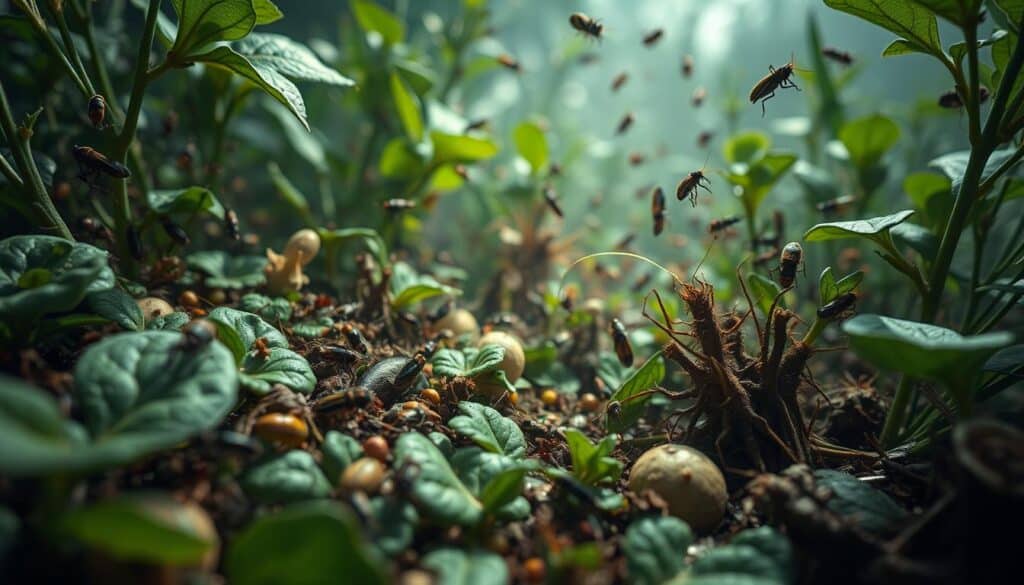Anúncios
Gardeners often struggle with plant pests that can harm their plants. This article shares effective tactics to protect your garden from common pests. By using preventative steps and sustainable methods, you help your plants grow healthily.

Seek App
We’ll uncover how to handle these pests and use new strategies. You’ll learn the best ways to keep your garden looking great.
Anúncios
Understanding the Challenges of Plant Pests
Gardeners deal with a lot of plant pests that can hurt their crops. Pests like aphids, slugs, and caterpillars can cause problems, making plants sick and less productive. Knowing what pests are in your garden is key to dealing with them.
Knowing how these pests live and behave helps gardeners make better plans to fight them. This means knowing when pests are most active. For example, seeing early signs like droopy leaves can lead to quick action to stop more damage.
Anúncios
Being aware of main pest threats means gardeners can prevent problems before they start. By keeping an eye on their plants and noticing any changes, gardeners can better handle pests. This keeps plants thriving.

Grow Resistant Varieties
Choosing plants that can fight off pests is a top way to protect your garden. Now, many seed catalogs offer seeds that are tough against pests, making it easier to keep your crops safe. For instance, some carrots are less likely to attract carrot flies and certain potatoes are better at resisting eelworms.
By picking these strong seeds, gardeners face fewer bugs and don’t have to use as many chemicals. This makes taking care of plants simpler and helps our planet too.
Finding and using these sturdy plant types leads to a healthier garden and a wider variety of crops. It’s a smart move for growers looking to have plants that do well, even when pests are around. This choice supports farming that’s good for our earth in the long run.
Confusing Plant Pests through Interplanting
Interplanting is a smart way to fight off plant pests. By growing different plants together, gardeners can make it harder for pests to find their favorite food. This mix of plants stops pests from easily finding and infesting crops.
Benefits of a Diverse Planting Scheme
Using a variety of plants has many benefits:
- It lowers the number of pests by interrupting how they eat and breed.
- This method also increases the number of different living things in the area, making the ecosystem stronger.
- More pollinators like bees will visit, which is good for fruits and vegetables.
Examples of Successful Interplanting
Many gardeners have seen success with interplanting. For instance, marigolds and vegetables grow well together. The smell from marigolds keeps many bugs away. Also, herbs like basil or cilantro can be planted with tomatoes. This not only fights off pests but makes tomatoes taste better. These examples show how well-thought-out plant combinations can discourage pests and boost the health of your garden.
Timing Your Planting to Avoid Pest Peaks
Timing your garden right is key to less pest trouble. Every pest has its high season. Let’s take flea beetles as an example. They are most common in midsummer. If you plan your garden timing well, you can dodge a lot of damage from them.
Growing certain plants, like Asian greens, in fall is smart. Flea beetles aren’t as active then. Also, planting quick-growing crops early works well. They can beat the pests to the punch, maturing before the critters get busy.
With a smart planting plan, you can miss the worst of pest seasons. Knowing when pests are likely to show up is crucial. This knowledge can lead to a garden full of produce, not problems.
Utilizing Physical Barriers for Protection
Putting up physical barriers is a smart way to keep pests out of gardens. By using different kinds of barriers, gardeners can stop pests from getting to plants but still let them grow well. These methods act like armor for plants, keeping the pests away and saving your crops.
Types of Barriers
- Insect Nets: These light meshes let sunlight and water in but keep bugs out.
- Floating Row Covers: These spun fabric covers shield plants from pests and bad weather.
- Cloches: Clear covers that act like mini greenhouses, protecting from pests and controlling temperature.
How to Install Barriers Effectively
Putting barriers up right is key for pest defense. Make sure they’re tight around the edges to stop pests from sneaking in. Don’t let barriers touch the plants too much to keep air flowing and stop disease. Always check on your barriers for any tears or holes and fix them to keep pests out.
Attracting Beneficial Bugs for Natural Pest Control
Beneficial bugs like ladybugs, lacewings, and parasitic wasps are crucial for plant health. They act as natural pest control. To get more of these good bugs in your garden, you need to use special strategies.
Types of Beneficial Insects
Knowing about different helpful insects lets gardeners choose the right plants. This creates a garden that naturally controls pests. Some common ones include:
- Ladybugs: Great at eating aphids and other pests.
- Lacewings: Love to eat thrips and caterpillars.
- Parasitic Wasps: Lay eggs in pests, controlling their numbers.
How to Create an Attractive Environment for Beneficial Bugs
To invite beneficial bugs, create a friendly space for them. Here are some tips:
- Plant various flowers like dill and yarrow. They offer food for the bugs.
- Put flower borders near your veggies to give shelter and food to helpful insects.
- Stay away from chemical pesticides. They can hurt the good bugs and mess up natural pest control.
This method does more than help control pests. It also increases biodiversity, making your garden’s ecosystem balanced.
Organic Pest Control Methods
Organic pest control methods offer a safer choice compared to harmful synthetic pesticides. They focus on using natural elements. These elements help keep pests away but protect friendly insects. For example, planting certain plants together keeps pests away naturally.
Making your own natural pesticides is another good choice. You can use safe ingredients like neem oil, garlic, and soap. Mix them to make sprays that fight pests without hurting nature. These organic strategies help gardeners reduce their impact on the planet. They also create a better environment for their gardens.
When gardeners pick these organic options, they support farming that cares for the earth. Organic pest control is key for plant health. It’s also important for keeping the garden’s natural balance.
Implementing Integrated Pest Management (IPM) Techniques
Integrated Pest Management (IPM) aims to tackle pest problems responsibly. It blends many pest control methods. This way, it keeps both nature and farming thriving. Checking pests often is key for IPM to work well. It helps act fast and make smart choices.
It’s vital to mix preventive actions with reactive steps in this system. Things like changing crops and keeping gardens clean help avoid pests. Adding pests’ natural enemies also helps control them without depending fully on chemicals.
If other methods don’t cut it, targeted chemicals might be used. These carefully chosen treatments lessen harm to the environment. They still fight off pests effectively. IPM offers a green answer to pest issues, covering various pest challenges.
Cultural Practices for Preventing Plant Pests
Cultural strategies are key in keeping pests away from gardens. Using crop rotation helps break pest life cycles, cutting down their numbers. Growing different types of plants boosts biodiversity and stops pests that target specific plants.
Keeping plants spaced out improves air flow, which helps stop diseases that attract pests. Watering plants the right way keeps the garden healthy. Strong plants can fight off pests and diseases easier.
- Adopt crop rotation to prevent specific pest build-up.
- Encourage diversity in plant varieties to deter pests.
- Ensure adequate spacing between plants for better airflow.
- Practice efficient watering techniques to promote plant health.
Using these cultural practices helps gardeners make a tough place for pests to live. This leads to healthier gardens without much use of chemicals.
Conclusion
In summary, keeping your garden healthy means managing pests well. We’ve found various strong methods to face plant pest challenges. Gardeners have tools like growing plants that pests dislike, setting up barriers, and increasing crop diversity to lower the number of pests.
Also, attracting helpful insects is key to fighting garden pests naturally. By making your garden welcoming to these allies, you can use nature’s own way to fight pests. Using organic methods and Integrated Pest Management (IPM) helps garden health and supports a lively ecosystem too.
By using these detailed strategies, managing pests successfully is achievable. Practicing these methods leads to lush, beautiful gardens that stand strong against pests. No matter if you’re new to gardening or have been doing it for years, these tips can make your gardening better.



